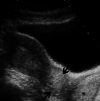An Unusual Presentation of Villoglandular Papillary Adenocarcinoma in a Perimenopausal Woman
- PMID: 38505429
- PMCID: PMC10948958
- DOI: 10.7759/cureus.54374
An Unusual Presentation of Villoglandular Papillary Adenocarcinoma in a Perimenopausal Woman
Abstract
Villoglandular papillary adenocarcinoma (VPA) or villoglandular adenocarcinoma (VGA) is a rare but well-recognized subtype of cervical carcinoma. It exhibits a favorable prognosis, particularly within the childbearing age group, and is considered a rare manifestation of mucinous adenocarcinoma typically observed in individuals of reproductive age. In comparison to other adenocarcinomas, VPA generally demonstrates a more optimistic prognosis. This report details the case of a 46-year-old perimenopausal woman who presented with complaints of irregular menses and a protruding mass from the vagina. Upon examination, an exophytic growth was identified, replacing the cervix. A biopsy confirmed the diagnosis of VPA. Subsequently, the patient underwent a radical hysterectomy, followed by post-operative radiation therapy.
Keywords: cervical cancer; endocervicitis; malignancy; perimenopausal woman; radical hysterectomy; villoglandular papillary adenocarcinoma.
Copyright © 2024, Nair et al.
Conflict of interest statement
The authors have declared that no competing interests exist.
Figures



Similar articles
-
Villoglandular papillary adenocarcinoma of the uterine cervix in a pregnant woman: a case report and review of literature.Tohoku J Exp Med. 2004 Apr;202(4):305-10. doi: 10.1620/tjem.202.305. Tohoku J Exp Med. 2004. PMID: 15109129 Review.
-
Villoglandular Adenocarcinoma of the Uterine Cervix: A Case Report.J Menopausal Med. 2023 Dec;29(3):150-153. doi: 10.6118/jmm.23020. J Menopausal Med. 2023. PMID: 38230601 Free PMC article.
-
Liquid-based cytology of villoglandular adenocarcinoma of the cervix: a report of 3 cases.Korean J Pathol. 2012 Apr;46(2):215-20. doi: 10.4132/KoreanJPathol.2012.46.2.215. Epub 2012 Apr 25. Korean J Pathol. 2012. PMID: 23110005 Free PMC article.
-
Cervical implant from villoglandular endometrial adenocarcinoma masquerading as cervical villoglandular adenocarcinoma.Int J Gynecol Cancer. 2002 May-Jun;12(3):308-11. doi: 10.1046/j.1525-1438.2002.01106.x. Int J Gynecol Cancer. 2002. PMID: 12060454
-
Villoglandular papillary adenocarcinoma of the uterine cervix.Eur J Obstet Gynecol Reprod Biol. 1999 Sep;86(1):101-3. doi: 10.1016/s0301-2115(99)00047-0. Eur J Obstet Gynecol Reprod Biol. 1999. PMID: 10471150 Review.
References
-
- Villoglandular papillary adenocarcinoma of the uterine cervix: a clinicopathologic analysis of 13 cases. Young RH, Scully RE. Cancer. 1989;63:1773–1779. - PubMed
-
- Scully RE, Bonfiglio TA, Kurman RJ, Silverberg SG, Wilkinson EJ. Geburtshilfe Frauenheilkd. Vol. 81. New York, USA: Springer Berlin, Heidelberg; 1994. Histological typing of female genital tract tumors (international histological classification of tumors) pp. 1145–1153.
-
- Well-differentiated villoglandular adenocarcinoma of the uterine cervix: oncogene/tumor suppressor gene alterations and human papillomavirus genotyping. Jones MW, Kounelis S, Papadaki H, Bakker A, Swalsky PA, Woods J, Finkelstein SD. Int J Gynecol Pathol. 2000;19:110–117. - PubMed
-
- Benign and malignant pathology of the cervix, including screening. Liao SY, Manetta A. http://pubmed.ncbi.nlm.nih.gov/8400047. Curr Opin Obstet Gynecol. 1993;5:497–503. - PubMed
-
- Prevalence of human papillomavirus DNA in various histological subtypes of cervical adenocarcinoma: a population-based study. An HJ, Kim KR, Kim IS, et al. Mod Pathol. 2005;18:528–534. - PubMed
Publication types
LinkOut - more resources
Full Text Sources
